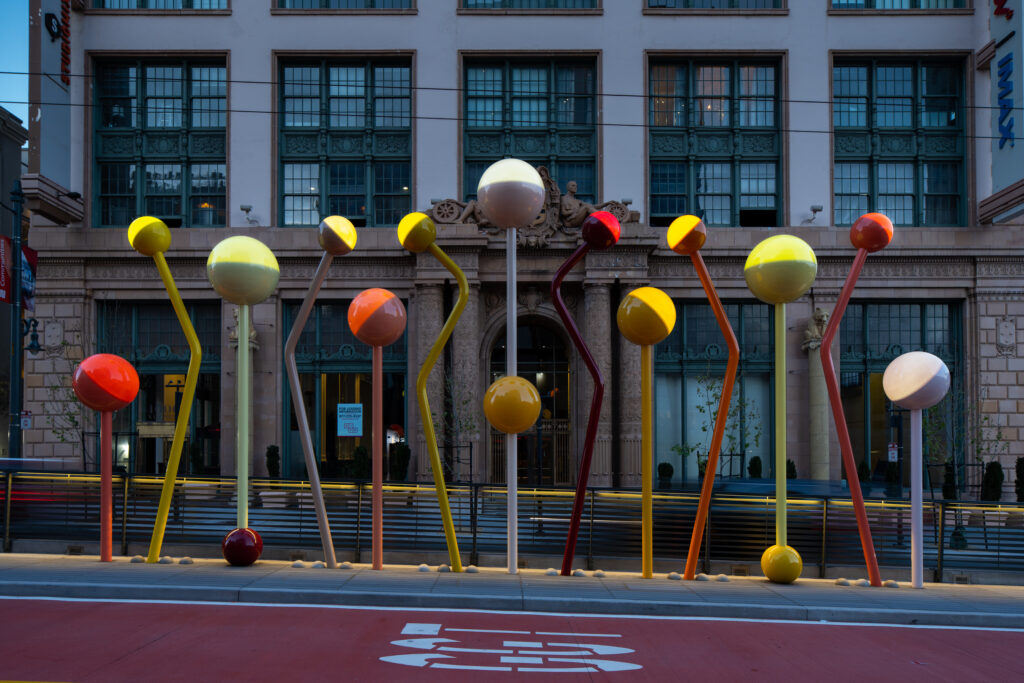
Jorge Pardo’s new sculpture installation on Van Ness Avenue looks great from the sidewalk, from the transit platforms between O’Farrell Street and Geary Boulevard where they are placed, and even from a passing car.
But if you get the right seat on a Muni bus using the street’s new rapid transit lane, it’s an event.
The untitled work — two sets of sculptures consisting of 13 steel figures that soar to 21 feet at their tallest, topped by acrylic and fiberglass spheres — was dedicated in April on the two-block stretch, part of the $346 million Van Ness Rapid Transit project on that street. Each of the two platforms has an installation identical in form but painted in different shades consisting of citrus and peach tones, cool greens and turquoise, a palette that I can’t help but associate with both the paintings of Wassily Kandinsky and Japanese gummy candies.
By night, the top halves of the spheres light up. They’re programmed to turn on 20 minutes before sunset and turn off 20 minutes before sunrise, according to Jackie von Treskow, the senior program manager for the San Francisco Arts Commission, which approved the project.
In his proposal to the commission, Pardo, a Los Angeles-based artist known for his site-specific projects, described the work as “an urban coastal redwood” and “an urban machine” that is “made of steel, light and weather.”

Pardo, who was born in Cuba, is a MacArthur Fellowship awardee whose commissions include a number of bold experiments that are uniquely intertwined with place. “4166 Sea View Lane” saw Pardo build a house for himself as an object of sculpture for the Museum of Contemporary Art in Los Angeles in 1998; “Project” from 2000-01 involved a redesign of the lobby of a Dia Art Foundation building in New York, including adding a full-scale replica of a 1994 Volkswagen Beetle; and in 2007, he created “Madrazo Tecoh Project,” where he turned a ruined estate near Mérida, Mexico, into an immersive installation.
Given the importance of location in these other projects, it doesn’t surprise me that his forms feel so well situated on Van Ness. That’s why it’s surprised me how little attention the work has gotten since its unveiling a few months ago.
When seen during the day, they’re a whimsical but thoughtful sculpture that adds much to that stretch, which is home to the sleek, new Coterie Cathedral Hill senior living facility, the stately 1921 building that houses the newCGVmovie theater, an unassuming Courtyard by Marriott hotel, the beige-on-beige Avenues senior living building, and the beloved local kitsch that is the Tommy’s Joynt restaurant mural. The work is in juxtaposition with the first three and in communion with the fourth.

当我第一次看到sidewal安装k, then inspected the sculptures more closely from the transit platforms one sunny day, it brought to mind the work of the 1980s Memphis design movement and reminded me of musical notes — transit riders bracing themselves against the whoosh of the passing bus — and also lollipops and even punctuation. Viewing them from the elevated seating section of a Muni bus as it drives by, they suddenly become more like the trees Pardo references in his statement, with their varying levels keeping the eye moving and creating a line of motion that recalls an arboreal canopy.
When lit at night, they transform the area, the illumination making them look even more candy-like as the colors gain an added vibrancy from the LED glow.
The finished result is an optimistic piece of public art that’s arrived at a time and place that needs some positive visual cues. That they feel equally accessible for viewing from passing public transportation as they do from the sidewalk has a 21st century ethos. With everything going on in the world (or even just San Francisco), I get why public art isn’t always the first thing on people’s minds. But this very public art work deserves our attention. All it asks is that we look.

